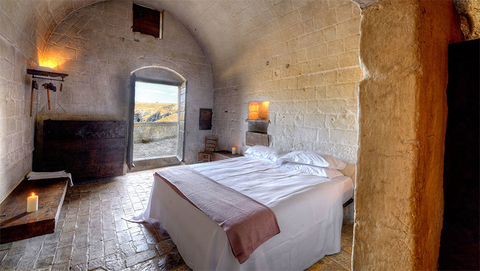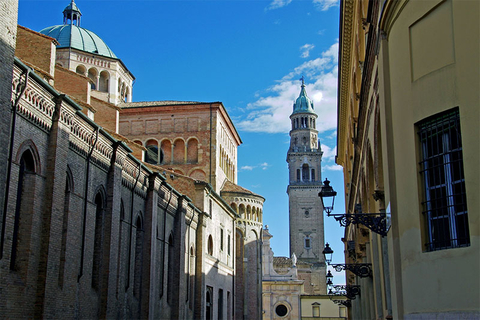When planning Italy vacations for next year, travel professionals’ eyes may be looking south, thanks to the selection of Matera as a European Capital of Culture for 2019 (along with Plovdiv, Bulgaria). It is the fourth Italian city so designated and the first since Genoa in 2004. The others were Bologna (2000) and Florence, the second-ever European Capital of Culture (1986). This honor will also call attention to the surrounding region of Basilicata — the arch of Italy’s boot, between Puglia and Calabria.
“The enchanting city of Matera is famous for its ‘Sassi’ or cave dwellings carved into the hillside,” Jill Taylor, an Italy specialist with Jetset World Travel in Chicago, tells Travel Agent. “The town has flourished in recent years after a period of abandonment. The Sassi are now used as residences, shops, restaurants and hotels. [Guides can] take you on a walking tour of the Sassi district and bring to life the history of this extraordinary town.”
Regarding accommodations, Taylor, a frequent visitor to Italy, says, “We typically book Sextantio [Le Grotte della Civita]. Love the team there and clients love it. I have stayed at Hotel Sant’Angelo as well. Another fun plan is to stay at Palazzo Margherita [in Bernalda, about a 40-minute drive south of Matera] and then do a day tour into Matera.”
The Sextantio’s rooms and suites occupy a series of vaulted caves; in fact, that’s how they are designated on the hotel’s website. The Executive Suites are Cave 4 and Cave 8, for example. The Bridal Suite, the Sextantio’s only multi-level unit, is Cave 13; if your couples are superstitious, they can always opt for Cave 7, among 20-plus others. You can also book a candlelight dinner for them in the 13th-century rock-hewn church.
The Sant’Angelo likewise is the product of a careful restoration of the 18th-century local royal court building, the old cave houses and a cave church. Both hotels offer guests the charm of the Sassi, with all the comforts of a contemporary and exclusive resort.

Not all of the underground chambers have been converted to hotels, however. There are still uninhabited grottos on the edge of town that clients can explore.
“We always have clients do a half day Sassi tour,” Taylor tells us. “I would [also] suggest a fun cooking class in one of the local homes, paired with wine from nearby.” ItalyXP, Select Italy and Viator are among tour companies offering such programs, and Palazzo Margherita hosts a class focusing on traditional pasta making.
“There is [also] a fun quad bike tour around the area, as well as a visit to the Murgia Plateau. From Belvedere di Murgia Timone, you can take in the amazing views of the Sassi and Gravina [ravine]. It is good to get the perspective from here,” Taylor says.
Other attractions in Matera include the ancient Benedictine Cripta del Peccato Originale (Crypt of the Original Sin), which contains frescoes of biblical figures dating to the 8th century, and Casa Noha. The latter, not far from the Matera Cathedral, is considered to be a gateway for visitors to learn the area’s history. Carefully conserved by FAI (Fondo Ambiente Italiano, The National Trust for Italy), it has walls made of tufa (a kind of porous limestone), vaulted ceilings, cornices and carvings, all typical of the architecture of the Sassi. A multimedia presentation describes the area from various perspectives, encompassing everything from architecture and archaeology to the history of art and cinema. Sharp-eyed silver-screen enthusiasts will note that much of the Mel Gibson’s “The Passion of the Christ,” Bruce Beresford’s “King David” and several other biblical movies were filmed in Matera.
Matera is one of the oldest continuously inhabited cities in the world, dating back to the Paleolithic period. In 1993, UNESCO declared its historical center Sassi and the Rupestrian Churches park a World Heritage Site.
Palermo, Sicily
Every year, Italy’s Ministry of Culture and Tourism designates an Italian Capital of Culture, and while not all go on to claim the Europe-wide title, they are worthy of your clients’ consideration. After being declared a UNESCO World Heritage Site in 2016, Palermo, Sicily, was chosen as the Italian Capital of Culture for 2018.
Among the historical and cultural attractions in Palermo are the baroque Church of Casa Professa, consecrated in 1636; the Stanze al Genio Museum, home to more than 3,000 hand-painted majolica tiles and murals, many dating to the 16th century; Teatro Massimo, where opera, ballet and symphonies are performed; and the Antonio Pasqualino International Puppet Museum, currently housed inside the Hotel de France (a former 18th-century palace). In the city’s ancient Kalsa district, there’s the Palazzo Abatellis, which houses the Regional Gallery of modern art, and Palazzo Mirto, a noble residence dating to the 13th century and filled with Murano chandeliers, lacquered Chinese panels, clocks, tapestries and porcelains, as well as furnishings from as far back as the 7th century.
From June 16 to November 4, 2018, Palermo will host the 12th incarnation of Manifesta, an internationally acclaimed biennial festival of contemporary art. Works by both local and international artists are represented. The theme for Manifesta 12 in Palermo is “The Planetary Garden. Cultivating Coexistence.”
Accommodations in Palermo include an array of five-star hotels, such as Grand Hotel Wagner and Grand Hotel Villa Igiea – MGallery by Sofitel, and four-star properties, including Best Western Ai Cavalieri Hotel, Mercure Hotel Palermo Centro, Ibis Styles and NH Palermo. Also, just over an hour’s drive east, the brand new, all-inclusive “5-Trident” Club Med Cefalu, the newest member of the brand’s luxury Exclusive Collection, opened in June. Avanti Destinations, Collette and Perillo are among companies that operate tours of Sicily alone, or combined with other Italy destinations, that include days in Palermo.

Looking Ahead to Parma
Looking ahead, the northern city of Parma — virtually equidistant from Milan, Genoa and Bologna — has been named Italy’s Capital of Culture for 2020. The city is perhaps best known for Parmesan cheese and Parma ham, but it also has a long heritage as a world arts center. The birthplaces of composer Giuseppe Verdi and conductor Arturo Toscanini have been transformed into museums dedicated to their legacies, and every fall Teatro Regio di Parma and other venues hosts Festival Verdi (September 27 to October 21 in 2018), including a performance by Filarmonica Arturo Toscanini.
Six weeks every spring, the Parma 360 Festival is held in various public and private spaces hosting exhibitions of painting, photography and digital art, and sculpture, as well as concerts and other performing arts. Opera aficionados interested in Italy’s role in the history of the genre can check out the House of Music museum.
The Galleria Nazionale exhibits works by local 16th-century artists Parmigianino and Correggio, as well as paintings by Da Vinci and Canaletto. The University of Parma has a collection of more contemporary art, while many of the city’s churches are adorned with frescoes. For architecture enthusiasts, central Parma is a treasure trove of medieval, Renaissance and baroque edifices. Highlights include the 12th-century Parma cathedral, the octagonally shaped Baptistery, and Palazzo della Pilotta, which overlooks the Piazza of Peace. The Labirinto della Masone, the world’s largest maze, is also home to sculptures, design objects and cultural events.
As to where your clients can stay, choices include the five-star Palazzo Dalla Rosa Prati and Grand Hotel de la Ville, as well as properties by such familiar companies as Best Western Plus, Holiday Inn Express, Accor’s Ibis Styles and Mercure brands, and NH Hotel group.
Related Stories
Paris Foodie Tip: Beau & Fort Cheese Shop and Restaurant
Where to Drink in the World's Greatest Region for Wine
Overseas Adventure Travel Adds 500 Single Spaces for Fall Travel